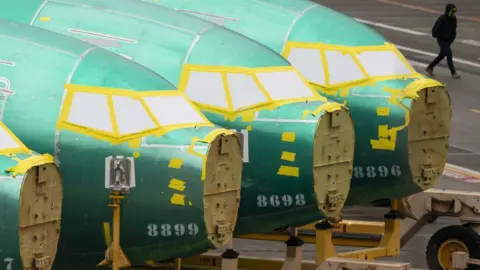Boeing production hit due to strikes and safety problems

 getty images
getty imagesTroubled aerospace giant Boeing says it delivered only 348 planes to its customers last year, its lowest output since the pandemic.
Boeing ended the year with a backlog of 5,595 unfulfilled orders.
An intense investigation into the aircraft manufacturer’s practices as well as industrial action has disrupted production at one of America’s largest manufacturers.
In contrast, its European arch-rival Airbus provided 766 aircraft.
Boeing said “work is underway” to improve its culture and “restore trust and delivery to our customers.”
The company’s production was interrupted in 2024, first due to serious concerns over quality control at both its own facilities and a major supplier.
Later in the year, a worker strike in the heartland of Washington state brought two of its most important factories to a halt.
These factors combined to bring its production down sharply from 528 aircraft delivered in 2023.
Boeing had a bad start to the year. In January 2024, a panel on an unused emergency exit door fell off a new 737 Max shortly after takeoff.
This incident left a big hole in the side of the plane. Investigators later concluded that the panel was not properly bolted into place.
The case put the quality control standards of Boeing and its primary supplier Spirit AeroSystems under a harsh spotlight.
An audit by the US regulator, the Federal Aviation Administration, found “numerous instances” where both companies failed to meet required standards.
Boeing was earlier planning to increase production of its best-selling aircraft, the 737 Max. Instead, its output was limited by the FAA.
It also faced intense public criticism over its apparent failure to improve safety standards after two previous crashes involving the 737 Max five years ago.
The manufacturer has since faced increased regulatory scrutiny, and is in the process of implementing a major safety and quality control improvement plan.
While grappling with the fallout from the January incident, Boeing was also dealing with supply chain problems.
These have been affecting the industry as a whole since the Covid pandemic. Production of the 787 Dreamliner and 777 freighter slowed due to a shortage of parts, including engines.
In September, Boeing suffered another serious blow when more than 33,000 workers in the US Northwest went on strike.
The dispute, which focused on pay and retirement provisions, was the first major walkout at the company since 2008.
It halted work at major Boeing factories in the Seattle area, halting production of the 737, 777 and 767 freighters.
The strike ended in early November, but disruption continued for several weeks. The 737 MAX production line did not restart until mid-December.
Boeing’s problems, which have cost the company billions of dollars in losses, have also created headaches for airlines.
Even before last year’s events, it was struggling to produce aircraft rapidly and the company now has a large backlog of unfulfilled orders.
The 528 aircraft delivered in 2023 were far short of the pre-Covid era record of 806 set in 2018.
Airbus is in much better shape, but still fell slightly short of production targets last year as it struggled with its supply chain issues. Its order backlog now stands at more than 8,600.
With Airbus unable to compensate for Boeing’s shortage, airlines are struggling to get the aircraft they want.
In November, Ryanair chief executive Michael O’Leary described the delay in acquiring new aircraft as “a pain in the rear”.
The airline has repeatedly warned that the shortage of planes will hurt its growth plans and limit the number of passengers it can fly this summer.





